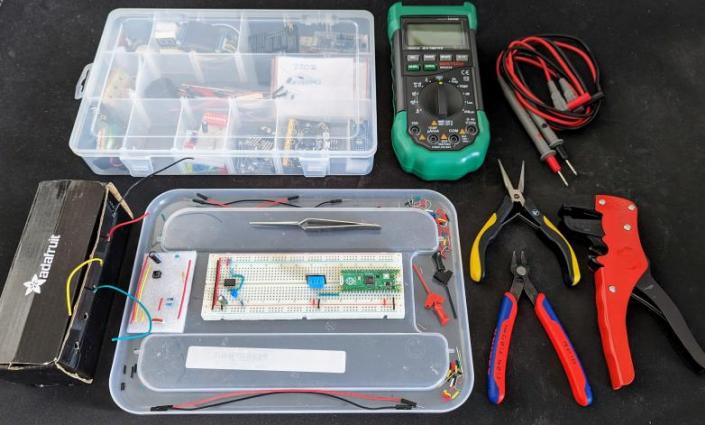Electronics Workbench 0.1
First steps into the world of basic electronics and micro-controllers as student or hobbyist, then I would recommend to keep it simple. Following you see a picture of my working setup. I do not have an electronics work bench and I’m not planing to have one. I would assume most people underestimate how much you can learn in this field without any major investment. No expensive equipment like an oscilloscope, bench power supply or soldering station required in order to learn a lot of the foundation principles and technologies.

Yes, you do need a computer in addition. If you do not own one yet, I’ll recommend a Raspberry Pi 400 with an affordable monitor. (Note that a Raspberry Pi includes the capability to connect with external circuitry. Depending on your journey into the topic, it may already be enough to start. Hence you eventually do not need to buy an addition micro-controller.)
Look out for an affordable electronics kit which already includes the micro-controller you want to start with. Usually these kits have a decent box, a breadboard and all the basic components like LEDs, resistors, switches and so on. Depending on the vendor even a simple display and some sensors may be part of the package.
I highly recommend to work with good wire:
- 0.6mm is the preferred diameter
- A hand full of colors including red and black
- Tools to cut and bend these wires
- A wire striper (do not spend to much on this)
Note that almost all electronics kits include jumper wire, therefore you could consider the above recommendation optional. Personally I believe that cutting and bending wire adds a lot to the experience (in particular for beginners). Using good wire improves contacts with the breadboard resulting in a more robust circuit. Shaky contacts with jumper wire can be a source of frustration in particular when circuits get more complicated, or even expand to a second breadboard.
You most likely will require a multimeter at some point. Go ahead and learn about these using Youtube, since video is much more suitable to explain the basics of such a tool. There a plenty of videos reviewing the available multimeters in all price ranges. I’ll leave it to you to select a suitable model, however again I’ll recommend to not spend to much on this (unless you want to us the multimeter outside of low-voltage electronics).
Many would add a solder iron to the most basic tooling. I can understand that, but it is not necessary. Most entry-level electronic kits provide all components in a breadboard ready state (including the micro-controller). I would consider everything for soldering an upgrade to the 0.2 electronics workbench. Similar for the 0.2 workbench you may need an “cheap” oscilloscope, I’ll recommend to take a look to the previous article about Scoopy.
If you take a peek into the storage box, you’ll notice that it holds multiple micro-controllers, other integrated circuit chips, and a selection of displays and sensors. That’s the way it typically goes. If you dive into this topic for educational purpose I would recommend to re-use components as much as possible, and to avoid acquiring to much stuff. Keep to footprint small. Everything should fit into a single bigger box which is easy to store out of the way. The effort of storing and re-accessing everything should not present a barrier keeping you from re-visiting just for fun on any given time.